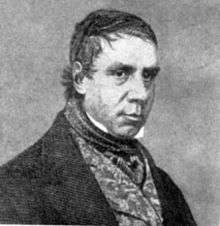Carel Hendrik Bartels
| Carel Hendrik Bartels | |
|---|---|
 | |
| Born |
September 29, 1792 Elmina, Dutch Gold Coast |
| Died |
February 10, 1850 (aged 57) Elmina, Dutch Gold Coast |
| Occupation | trader, businessman, judge |
| Religion | Wesleyan Church |
| Spouse(s) | Adjua Ere-ëba |
Carel Hendrik Bartels (29 September 1792 – 10 February 1850) was the wealthiest and most important mulatto trader and businessman on the Dutch Gold Coast in the second quarter of the nineteenth century.[1] Apart from his entrepreneurial activities, Bartels was also a judge and member of the colonial government in Elmina, making him one of the most important men in town.
Bartels has an entry in Hutchison's The Pen-Pictures of Modern Africans and African Celebrities.[2]
Biography
Carel Hendrik Bartels was born in Elmina to Cornelius Ludewich Bartels, Governor-General of the Gold Coast, and the local mulatto Maria Clericq.[3] Little is known about his youth, but it is known that he was sent to the Netherlands for his education. In August 1814, Bartels returned to the Gold Coast with the first ship after the defeat of Napoleon Bonaparte at the Battle of Leipzig, and acted as the official messenger of the Dutch authorities for this news.[3]
Between 1814 and 1820, Bartels was employed in the colonial administration of the Gold Coast. From 1839 onward, Bartels acted as judge in the Court of Justice of Elmina, and was a member of the colonial council.[3]

Bartels died on 10 February 1850. He is interred in the Dutch cemetery of Elmina.
Family
Bartels is the founder of the influential mulatto Bartels family on the Gold Coast. He was married to Adjua Ere-ëba, with whom he had five daughters and a son:[3]
- Manza Henrietta Bartels, who married Governor Anthony van der Eb
- Amba Amelia Bartels (1816–1882)
- Maria Amba Bartels (1822–1863)
- Willem Bartels (1823–1844)
- Jacoba Araba Bartels (1824–1848), who married Governor Willem George Frederik Derx
- Anna Esson Bartels (1829–1907)
Bartels also had a son out of an extra-marrital affair with mulatto Catharina Rühle:[3]
- Louis Bartels (1818–1857)
Lastly, Bartels had four children with Amba Praba:[3]
- Charlotte Bartels (1817–1873)
- Carel Bartels (1818–1890)
- Christina Bartels (1826–1854)
- Jacob Bartels (1830–1872)
Notes
- ↑ Doortmont 2004, p. 121
- ↑ Doortmont 2004, pp. 121-122
- 1 2 3 4 5 6 "Bartels, Carel Hendrik". GoldCoastDataBase. 2012-04-06. Retrieved 19 April 2012.
References
- Doortmont, Michel (2004). The pen-pictures of modern Africans and African celebrities by Charles Francis Hutchison: a collective biography of elite society in the Gold Coast Colony. Leiden: Brill. ISBN 9789004140974.